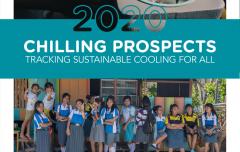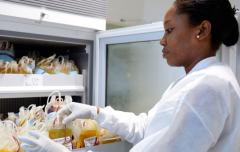Sustainable cooling solutions
Green, clean, efficient and climate friendly are all terms that are used to describe sustainable cooling. But what are sustainable cooling solutions?
#ThisIsCool: Explore the sustainable cooling solutions directory and tool
There is a range of sustainable cooling solutions that need to gain a larger market share to achieve global climate and the Sustainable Development Goals (SDGs). These include some of the most efficient fans, air conditioners and refrigerators; measures to reduce the need for cooling through insulation, shading, reflectivity or ventilation; and using collective effort to deliver more sustainable products, services, policies and financial solutions to meet cooling needs and provide cooling benefits.
Cooling for All solutions
In a warming world, access to sustainable cooling is not a luxury. It is an issue of equity and a service that must be delivered to all to achieve SDG7. Cooling for all does not mean an air conditioner or a refrigerator in every home; it means providing more sustainable and affordable solutions to address the needs of the vulnerable, such as access to nutritious food and safe medicines, and protection from heat as the world transitions to clean energy. Beyond achieving the basic needs for cooling, these same sustainable cooling solutions also deliver significant benefits across the economy to countries, companies and the population at large.
The purpose of this chapter is to explore what sustainable cooling solutions are and to build a conversation with partners that can support the achievement of cooling for all. It is a starting point from which to develop the Cooling for All Solutions Assessment toolkit, which will support users to understand the right solutions based on their cooling needs. The framework used in this chapter for sustainable cooling solutions is to meet the three Cooling for All Needs with an optimized five-solution approach across the four solution pillars. This is described in more detail below, with the majority of the chapter examining the sustainable cooling solutions in the four solution pillars.
Cooling needs, solution approach and solution pillars
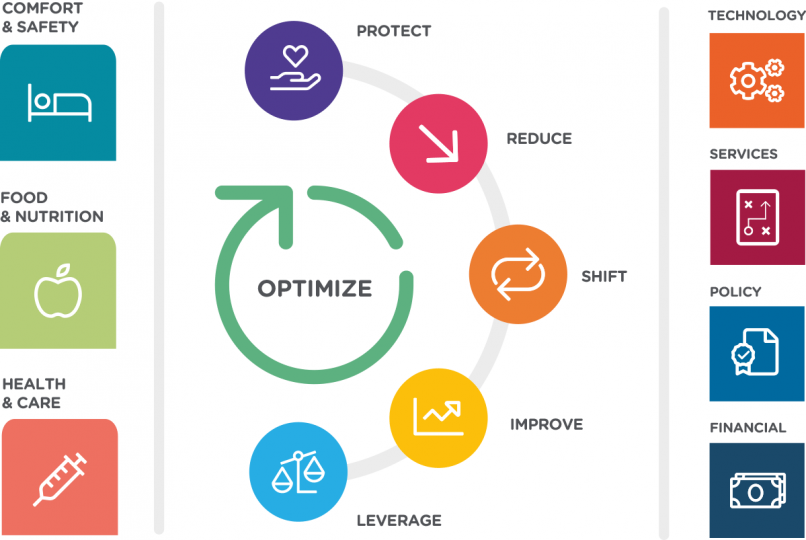
Cooling for All needs assessment
A necessary first step was taken in 2019, when the Cooling for All Secretariat at Sustainable Energy for All (SEforALL) and Heriot-Watt University partnered to create the Cooling for All Needs Assessment to understand cooling needs across buildings, cities, agriculture and health services. The consideration of cooling solutions must be grounded in an understanding of cooling needs that span multiple sectors, as identified in the Cooling for All Needs Assessment.
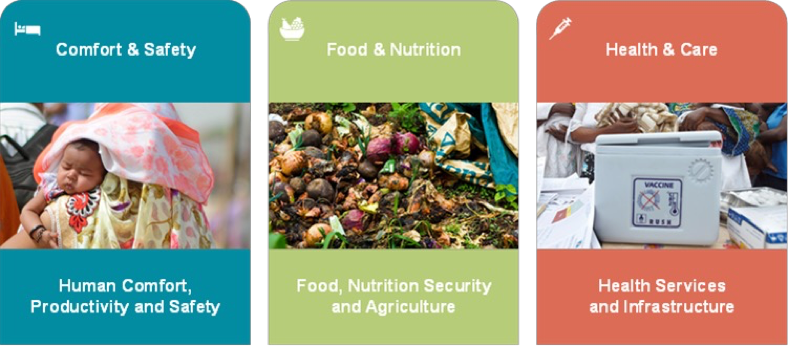
Comfort & Safety includes the need for people to have access to cooling for living, learning, working and mobility. There are levels of need, including for human thermal comfort and associated well-being; for productivity and linked incomes; and safety and health in extreme weather conditions.
Food & Nutrition includes the need for the agriculture sector to have access to cooling for food and nutrition security, rural incomes, and the agriculture cold chain.
Health & Care includes the need for the health care sector to have access to cooling for safe medical clinics and the secure transport and storage of vaccines and medical products.
While these fundamental needs are the focus of this chapter, sustainable cooling solutions can also support the transition to highly productive economies through other sectors, for example, industrial optimization or data centre cooling.
This year, the Cooling for All Secretariat is partnering again to create the Cooling for All Solutions Assessment toolkit that will launch in autumn 2020. This toolkit will include a process that will support governments and organizations to identify sustainable cooling solutions.
If you would like to be involved in further developing or testing the toolkit, please contact us at: coolingforall@seforall.org
Solution approach to achieving sustainable cooling
To enable analysis and optimization of cooling solutions, the first layer of classification is Protect, Reduce, Shift, Improve and Leverage – approaches or measures used to deliver more sustainable cooling, as distinguished by the Cool Coalition.
While “avoid, shift, improve” or “reduce, shift, improve” are already in use, this framework expands those concepts further in recognition of the needs of vulnerable populations with Protect as a starting point and the approach for delivering the solutions, and Leverage as an effective means for achieving impact.
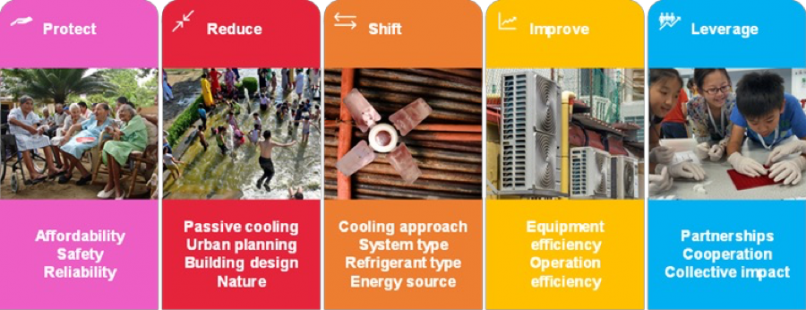
Protect approaches and measures reduce the vulnerability of people, businesses and governments to heat by using cooling solutions that are affordable, safe and reliable.
Reduce approaches and measures reduce the need for active or mechanical cooling solutions, and include using planning and design to reduce or even avoid the demand for active cooling.
Shift approaches and measures are those where simply a change of approach can deliver energy or emissions savings, such as through the use of renewable energy, natural refrigerants or conservation measures.
Improve approaches and measures include pure efficiency measures to achieve the same cooling service while using less energy (i.e. not using energy conservation measures).
Leverage approaches and measures support the achievement of a collective impact that is greater than the sum of individual efforts through cooperation and collaboration.
This five-solution approach supports a combination of both “early wins” and more systemic changes that are essential to achieve sustainable cooling for all. Optimization can support systemic changes to deliver against the consequences of cooling (energy, emissions) across multiple sectors that have inherent interdependencies across economic, energy, technology, mitigation, adaptation, social and political systems.
Sustainable cooling solution pillars
There is a range of sustainable cooling solutions that can be grouped into four key solution categories and that together can meet the needs and desires for cooling.
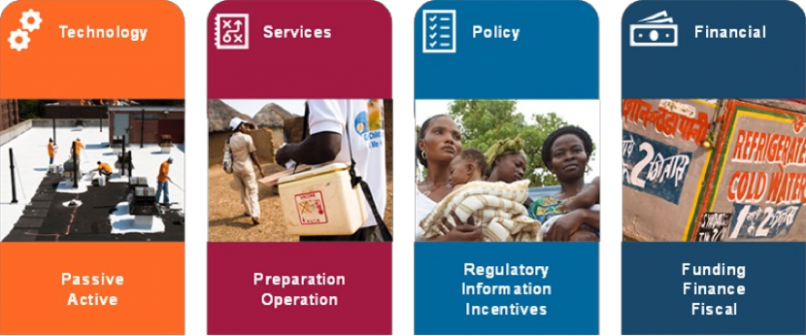
While technology solutions are the first type of solution that comes to most people’s minds when thinking about the best cooling solutions, a combination of these solutions is essential to building an enabling environment for investment in more sustainable cooling solutions and achieving long-term benefits. Programmes (initiatives or market-based instruments) are an important delivery mechanism for more sustainable solutions. Successful market transformation programmes include a combination of these solution types to create an enabling environment for investment in sustainable cooling and increased access to cooling (e.g. a programme that supports policy development, technology research, and financing the design, installation and maintenance of solutions).
Sustainable cooling solution measures
The categories above highlight a framework of three cooling needs, five solution approaches and four solution pillars that can be used to optimize cooling solutions for sustainability and access to cooling. While this chapter will not go into the details of each solution, the following sections explore where different measures fit within this framework. The tables below include general descriptions of key solutions and the associated coloured symbol for the solution approach achieved through the measure. While these are not comprehensive or definitive, they are a starting point to better understand the solutions that will be optimized in the Cooling for All Solutions Assessment toolkit.
Technology solutions
Technology deliver sustainable cooling through a range of materials, products and devices to support delivery of passive cooling and active cooling and include: (1) those measures that use no operational energy and no refrigerants (i.e. nature-based and passive technology solutions), and (2) those measures that use energy and refrigerants, but do so efficiently (i.e. active technology solutions).
Nature-based and passive technology solutions include a combination of traditional or indigenous low-tech and modern high-tech solutions. Some of the most effective low-tech solutions include nature-based solutions such as water, trees, plants and earth. Passive technologies are all Reduce measures, while most are also Protect measures for their ability to increase reliability of cooling and increase safety for vulnerable populations in extreme weather events.
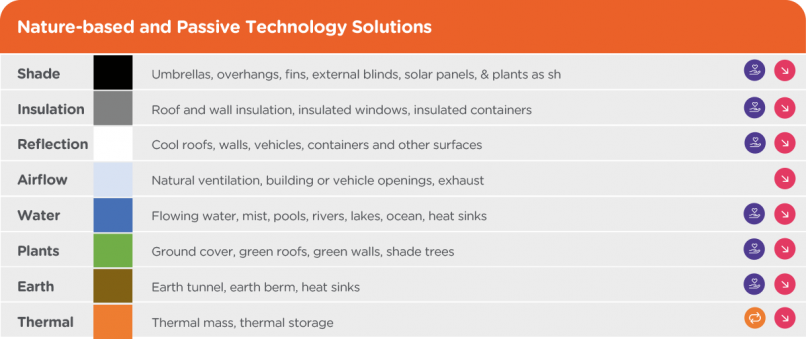
Active technology sustainable cooling solutions are a much wider group5 of solutions that range from a simple fan to a large district cooling system. Each technology has a range of achievable sustainability, and those technologies that are more efficient and have a smaller emissions impact are often more sustainable than others. In Table 2, the sustainability drivers include device efficiency, refrigerant type (impacting both efficiency and emissions),6 and energy source. While the key factors of efficiency and emissions are fundamental to active technology sustainability, the Cooling for All Solutions Assessment toolkit will further enable an assessment, which is not possible in this chapter, to optimize the combination of cooling solutions based on life-cycle sustainability.

Services solutions
Services solutions support the organization and delivery of cooling technologies and include (1) activities that support the preparation (e.g. theory and practical skills) to create or deploy more sustainable cooling solutions and (2) operational (e.g. operation, management and maintenance) activities to deliver and use more sustainable cooling. Without these services more sustainable technology solutions may not be available; in other words, the manner in which technologies are developed, sold, installed or used all have a bearing on sustainability, which are all dependent on services.
Preparational services, including fundamental education, skills development and project services, are key to improving behaviour and long-term decision-making on cooling. Education includes basic learning from primary school to university that can support better decision-making for a larger share of the population or increased innovation for a smaller group. Skills development is a form of education that can support practical decision- making through vocational and professional training. Project services, often by engineers, designers, architects or contractors, are fundamental to achieving more sustainable cooling access (e.g. urban planning enables the use of passive technologies and building design enables the use of more sustainable cooling technologies).

Operational services include the direct operation of cooling services, the management that supports cooling services and the maintenance that ensures that cooling services and technologies are operating sustainably. The operation of more sustainable cooling services can provide a one-stop-shop (e.g. a cooling centre or district cooling) or be a portion of the solution within a wider business model (e.g. cold chain). Management as a sustainable cooling service includes a range of activities that enable improved decision-making or behaviour. Maintenance services enable more sustainable technologies and services to operate at their optimal performance and increase their reliability during peak hours or for vulnerable populations.

Policy solutions
Policy solutions deliver more sustainable cooling through a range of measures that include a blend of (1) legally binding or “stick” measures (Regulatory), (2) teaching or “tambourine” measures (Information) and (3) motivational or “carrot” measures (Incentives).
Regulatory policies can be one of the most effective measures but are often the hardest to adopt and implement, depending on the cultural context and enforcement procedures. While regulatory policies are often difficult to enforce when they are initially created, having the policy in place can support common understanding of what is more sustainable. Codes and standards are commonly used, but there are significant gaps in the enforcement of both building codes and cooling product standards in many of the vulnerable high-risk countries. These minimum standards are an important baseline for market-based approaches and voluntary high-performance standards to enable market transformation over time.
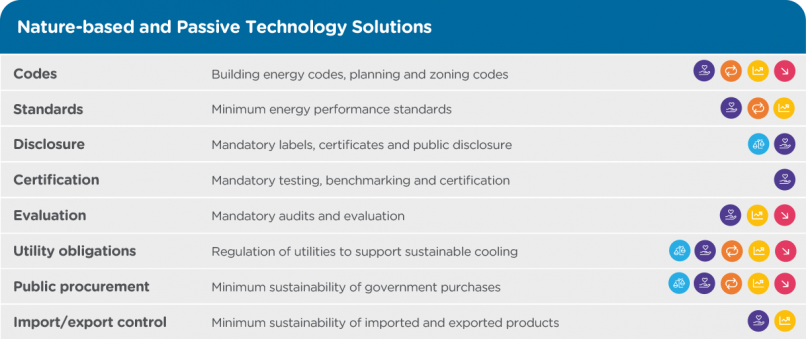
Information policies, including the use of voluntary information disclosure, certification, labels that indicate the level of sustainability, voluntary standards, and awareness-raising campaigns that inform people about cost-effective sustainable solutions enable more sustainable behaviour and support better decision-making.

Incentive policies can include both financial and non-financial incentives. While many first consider financial incentives to encourage people to purchase sustainable technologies or services, it is often the non-financial incentives that can be more sustainably delivered and achieve results. These policies should be considered in collaboration with the financial solutions that can enable private investment in sustainable solutions.

Financial solutions
Financial solutions deliver more sustainable cooling through a range of direct funding and indirect financial measures that can influence the cost effectiveness or first cost of more sustainable solutions, including through finance, fiscal instruments and funding measures. A combination of these financial solutions can be used together in the delivery of a financial programme; for example, a results-based financing or overseas development assistance programme should select a series of measures and work with a range of stakeholders to deliver the financial solutions to enable market transformation.
Finance solutions are intended to enable a temporary use of funds to purchase technologies or services. It is the temporary use of funds that can enable a more sustainable long-term funding approach to achieve both a lower monthly cost of solutions and the repayment of borrowed funds that can be used again for other projects. With limited funds available in many countries, finance measures can be key to creating an enabling environment for private investment in more sustainable solutions.
Finance solutions
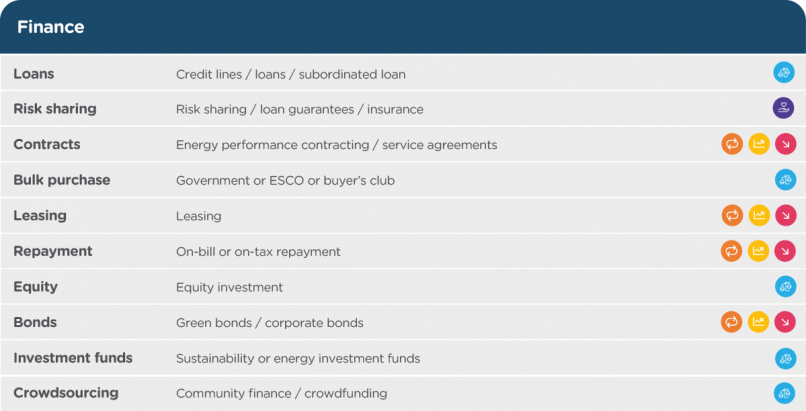
Fiscal solutions enable governments to influence decisions and can entail either income or expense for the government. Fiscal solutions can be created to financially support more sustainable cooling solutions and penalize the purchase of less sustainable measures. One key global expense that reduces the benefits of more sustainable cooling solutions is energy subsidies that do not properly reflect the actual cost of energy. Further influence on energy prices can be achieved by having an energy or carbon tax that reflects the societal cost of energy. Tax credits can be used to support the purchase of more sustainable measures, similar to a rebate or subsidy. Import/export control policy solutions and import/export duties fiscal solutions can be used in tandem to encourage the international trade of more sustainable solutions.

Funding solutions, such as grants or rebates, can be expensive compared to the total impact received, when compared to finance solutions that directly recoup the funds used to support the purchase of more sustainable cooling technologies or services. Funding provided to consumers or projects reduces the cost of more sustainable solutions without future repayment of the money received.


